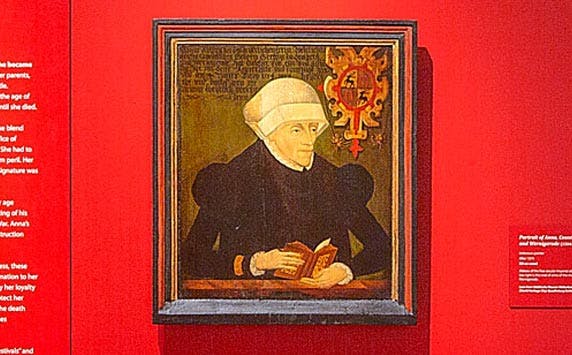About the Exhibit
The family lineages of European houses of nobility are continual sources of fascination, due to their long and storied histories. One of the oldest houses still in existence is the House of Stolberg, which originated in the heart of Germany in 1210. This dynasty had a deeply held bond with the Bible, revealed by an allusion to Psalm 31:14–15 imprinted on their coat of arms: “My destiny and my salvation lie in the hands of the Lord.”
In this exhibition presented by Museum of the Bible, we tell the stories of seven women from the House of Stolberg, highlighting the way the Bible served as their lives’ guiding principle and the standard for their decisions. Anna, the first woman presented in the exhibition, was born in 1504, and Magdalene, the last, died in 1955. Between them were Juliana, the “Mother of Maccabees”; Christine, the pious duchess; Sophie Eleonore, the Pietist collector; Louise Maximiliane, the “queen of hearts;” and Augusta Louise, “the unnamed beloved.”
These women ensured the permanence of the House of Stolberg through marriage, offspring and education, and their establishment and organization of networks throughout Europe. As abbesses, countesses, princesses, wives and mothers, they passed on values of family and faith to the next generations. All seven were strong women closely connected to family and children and to war, violence, and death. All seven found comfort and support, motivation, and hope in the Bible. This exhibition offers an intimate view into the lives of these seven very different personalities. Their portraits, letters and signatures displayed in the exhibition not only reveal their individuality but inspire curiosity to learn more about their thrilling lives.
Exhibition Details
July 1, 2018 - September 30, 2018
Past Exhibition
Located on Floor 5
Included with Admission

Family Tree

The family tree of the House of Stolberg begins with Botho, Count of Stolberg and Wernigerode (1467–1538) (Image Schimkat; from the Collections of the Prince of Stolberg-Wernigerode)

Coat of Arms

The coat of arms of the municipalities of Stolberg and Wernigerode uses black and gold, with a deer symbolizing House Stolberg and the two red trout symbolizing House Wernigerode. The heraldic motto of the counts of Stolberg-Wernigerode isSors salusque mea in minibus domini(My destiny and my salvation lie in the hands of the Lord), alluding to Psalm 31:14–15. (Image by Henning Goll; from the Collections of the Prince of Stolberg-Wernigerode)

Anna (1504-1574)

Anna became abbess of the famous imperial abbey in Quedlinburg at the age of eleven and led a life in accordance with the Bible. She carried out her demanding office for fifty-eight years until she died.

Juliana II (1506–1580)

Juliana was Anna’s sister, but her life unfolded differently. She was raised by Protestant relatives, married at seventeen and remarried after her husband’s death. She had seventeen children and ninety-seven grandchildren!

Christine (1663–1749)

Christine deepened her faith by engaging in her own writing. In her Meditationes (Meditations), she wrote commentaries on biblical texts, described her personal views and engaged in humble self-criticism. She embodied a living pietism characterized by its emotionally accentuated devoutness.

Sophie Eleonore (1669–1745)

Sophie Eleonore was not raised in a convent, and she never married. Notwithstanding her two passions—collecting funeral sermons and conducting meticulous genealogical research—she made an important personal contribution to the religious tradition of her house.

Louise Maximiliane (1752–1824)

Brought up in a Belgian convent, Louise Maximiliane was later gripped by the impulses of the Enlightenment. She had prospects of attaining the title of queen, suffered through a failing marriage and had several partners in life.

Augusta Louise (1753–1835)

Augusta Louise was raised a Pietist and placed in a former Cistercian convent. She learned English with the aid of an English Bible and was fascinated with Johann Wolfgang von Goethe and his novel “The Sorrows of Young Werther.” While the work contains numerous parallels to the Bible, some passages display violations of Christian doctrine.

Magdalene (1875–1955)

Magdalene served as the abbess of Drübeck Abbey for forty-seven years. She experienced the German Empire, World War I, the loss of the nobility’s sovereign rights, National Socialism (Nazism), World War II and the establishment of East Germany.
